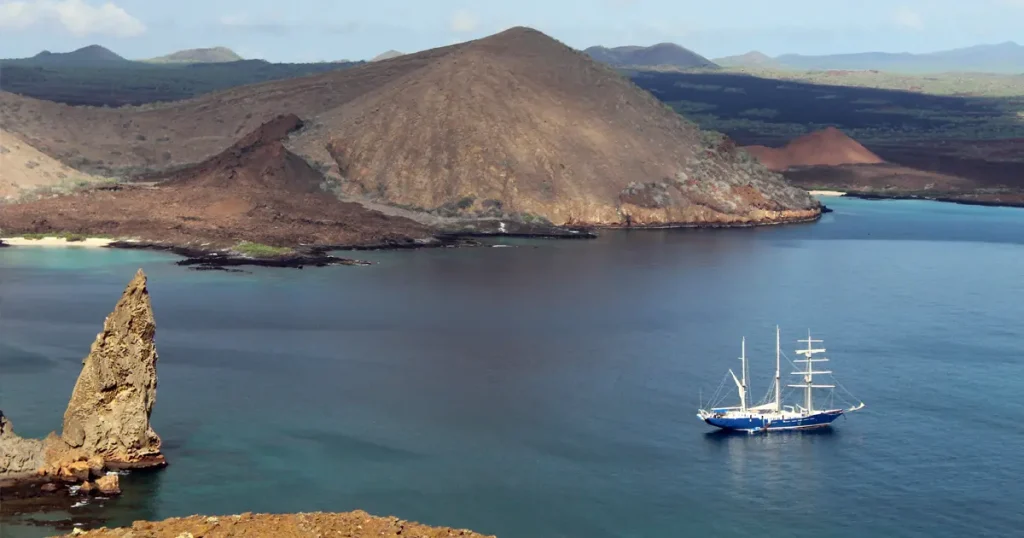Marine Ecosystem Research and Management
Milestones
- As of 2019, scientists had identified more than 53 non-native species in the Galapagos marine environment; that number is expected to increase with improved monitoring and expanded research.
- Settlement plates have been installed on the primary ports of Galapagos (Santa Cruz and San Cristóbal) and mainland Ecuador (Salinas, Guayaquil, and Manta) to detect any invasive species.
- Dr. Inti Keith of Charles Darwin Foundation named science group coordinator for the Eastern Tropical Pacific Marine Corridor. The multi-national group is coordinating marine conservation efforts throughout the region.
- A Marine Rapid Response Network, originally established by the Charles Darwin Foundation, is now coordinated by the Galapagos National Park Directorate.
Overview
Marine Invasives
The Galapagos Marine Reserve (GMR) is increasingly susceptible to the arrival and spread of invasive marine species because of ever-increasing marine traffic, climate change, and other factors. Up until recently, there were only six known well-established invasive species in the GMR: two species of algae, a crab, a starfish, and two species of plant-like animals that resemble ferns and mosses. In 2019, a study by the project research team identified more than 50 non-native species currently in the GMR, some of which may become invasive — and that the number could be higher still. The overarching goal of this project is to ensure the long-term conservation of the GMR by minimizing negative impacts of invasive species on marine biodiversity and the ecosystem.

Many marine species attach themselves to the bottom of boat hulls and are then transported around the world. When infected boats are in port and the attached species reproduce, they settle on and around the docks and pilings. The GMR has five main ports that are visited by an increasing number of yachts each year from both national and international ports. In addition, there are 70 terrestrial and 75 marine visitor sites in the Galapagos National Park. Many of these are visited daily by boat tour operators leaving from the five main ports.
The Charles Darwin Foundation’s Marine Invasive Project is establishing an early detection system in the main Galapagos ports, with support from Galapagos Conservancy. This will help local authorities quickly identify and eliminate marine invasives before they spread. The CDF group is collaborating with the Smithsonian Environmental Research Center to expand the deployment of settlement plates on other islands in Galapagos and throughout the Eastern Tropical Pacific.
A research team has set up various experiments to measure the spread of a species of algae (Caulerpa racemose) in bays off Fernandina and Isabela Islands, and to observe how seasonal changes in water temperature impact the spread of this species. The early detection system will serve as a replicable model for other marine protected areas in the region, as well as the rest of the world.
An added component of the marine invasive species program targets marine debris. Floating plastic, found throughout the oceans of the world, continues to increase and is slow to break down. In addition to the basic problem of plastic-filled oceans, the debris can transport invasive and foreign species over great distances, during long timeframes, and through geographical barriers.
This must be studied within the Galapagos Marine Reserve to limit, as much as possible, the threat of additional marine invasive species becoming established. In addition to occasional monitoring trips throughout the Archipelago (when funding and transport allow), sampling of foreign plastics that wash ashore at Tortuga Bay is conducted weekly.
Marine Rapid Response Network

Various factors threaten the health of many iconic marine species in the Galapagos Islands (e.g., penguins, cormorants, albatross, sea lions, fur seals, marine iguanas, sea turtles, dolphins, and whales). These include the rapidly expanding human population and tourism industry, an increase in contamination, maritime traffic and import of goods to the islands, introduced species, fishing, and changes in ecosystem structure and resource availability due to climate change.
In 2012, an emergency network to rapidly detect sick, injured, or dead marine wildlife was established. Prior to that, most animals that came ashore were simply left or buried on the beach, thereby losing important information about the cause of death and the health status of the species. The Rapid Response Network (RRN) was initiated by the Charles Darwin Foundation and is now run by the Galapagos National Park Directorate, with annual support from Galapagos Conservancy. The goal of the RRN is to aid marine fauna (mammals, reptiles, and seabirds) impacted by human activities in coastal areas of the inhabited islands. In the case of sick or injured animals, it offers rapid and effective rescue, veterinary clinical care, short-term recovery and, when possible, reintroduction to the wild.
Sea Turtle Monitoring

Since 2013, the Galapagos National Park Directorate has been responsible for the annual monitoring of green sea turtle beaches during nesting season, which they carry out in collaboration with the Charles Darwin Foundation. Galapagos Conservancy has been supporting this effort on an annual basis. Field teams work at two main nesting beaches, Quinta Playa on southern Isabela and Las Bachas on northern Santa Cruz. Data collection focuses on the number of nesting females (both new and returning), number of nests, levels of mortality, hatching success, and condition of the females. This annual monitoring of two key nesting beaches provides data vital to understanding any trends in the sea turtle population.
Long-Term Monitoring of Climate Oscillations in the Galapagos Marine Reserve
In 2018, Galapagos Conservancy provided its first grant to Dr. Jon Witman of Brown University who has been carrying out long-term research on the impact of El Niño Southern Oscillation (ENSO) events on the marine ecosystem. Project hypotheses of this research program after nearly two decades of monitoring include:

- Ocean temperatures in the central Galapagos subtidal have increased over the past 18-20 years;
- Coral populations are declining in the central Galapagos region;
- Coral bleaching associated with repeated ENSOs will foster regime shifts in Galapagos subtidal communities, transitioning from patchy coral reefs to either sponge-dominated reefs, or to barnacle-dominated reefs;
- ENSOs change: a) the biodiversity of epifaunal invertebrate communities, and/or b) the biodiversity and biogeographic origin of reef fish communities;
- The resilience of benthic invertebrate and reef fish communities is correlated with La Niña conditions (high nutrients and planktonic food);
- Pulses of high barnacle recruitment and abundance are: a) correlated with La Niña and /or b) have a lagged, positive effect on populations of their predators;
- Reef fish populations exposed to a “skin wasting” disease during the 2016 El Niño exhibit a lagged population decrease and/ or cause a change in ecosystem functioning.
Dr. Witman has made significant progress toward determining how repeated disturbances from ENSO events affect Galapagos marine ecosystem functioning and resilience in the context of global climate change. The research team regularly monitors changes in the ocean environment and marine life living in shallow (6 m depth) and deep (15 m) rocky habitats at 12 sites in the central Archipelago.



